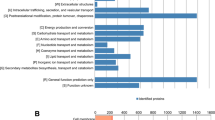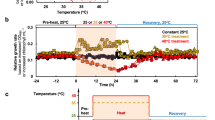Abstract
The Antarctic midge, Belgica antarctica, experiences sub-zero temperatures and desiccating conditions for much of the year, and in response to these environmental insults, larvae undergo rapid shifts in metabolism, mobilizing carbohydrate energy reserves to promote synthesis of low-molecular-mass osmoprotectants. In this study, we measured the expression of 11 metabolic genes in response to thermal and dehydration stress. During both heat and cold stress, we observed upregulation of phosphoenolpyruvate carboxykinase (pepck) and glycogen phosphorylase (gp) to support rapid glucose mobilization. In contrast, there was a general downregulation of pathways related to polyol, trehalose, and proline synthesis during both high- and low-temperature stress. Pepck was likewise upregulated in response to different types of dehydration stress; however, for many of the other genes, expression patterns depended on the nature of dehydration stress. Following fast dehydration, expression patterns were similar to those observed during thermal stress, i.e., upregulation of gp accompanied by downregulation of trehalose and proline synthetic genes. In contrast, gradual, prolonged dehydration (both at a constant temperature and in conjunction with chilling) promoted marked upregulation of genes responsible for trehalose and proline synthesis. On the whole, our data agree with known metabolic adaptations to stress in B. antarctica, although a few discrepancies between gene expression patterns and downstream metabolite contents point to fluxes that are not controlled at the level of transcription.






Similar content being viewed by others
References
Arrese EL, Soulages JL (2010) Insect fat body: energy, metabolism, and regulation. Annu Rev Entomol 55:207–225
Baker DA, Russell S (2009) Gene expression during Drosophila melanogaster egg development before and after reproductive diapause. BMC Genomics 10:242
Baust JG, Edwards JS (1979) Mechanisms of freezing tolerance in an antarctic midge, Belgica antarctica. Physiol Entomol 4:1–5
Baust JG, Lee RE (1981) Environmental “homeothermy” in an Antarctic insect. Antarct J US 15:170–172
Baust JG, Lee RE (1983) Population differences in antifreeze cryoprotectant accumulation patterns in an Antarctic insect. Oikos 40:120–124
Benjamini Y, Hochberg Y (1995) Controlling the false discovery rate—a practical and powerful approach to multiple testing. J R Stat Soc Ser B Stat Methodol 57:289–300
Benoit JB (2010) Water management by dormant insects: comparisons between dehydration resistance during summer aestivation and winter diapause. In: Navas CACJE (ed) Aestivation: molecular and physiological aspects, pp 209–229
Benoit JB, Lopez-Martinez G, Michaud MR, Elnitsky MA, Lee RE, Denlinger DL (2007) Mechanisms to reduce dehydration stress in larvae of the Antarctic midge, Belgica antarctica. J Insect Physiol 53:656–667
Benoit JB, Lopez-Martinez G, Elnitsky MA, Lee RE, Denlinger DL (2009) Dehydration-induced cross tolerance of Belgica antarctica larvae to cold and heat is facilitated by trehalose accumulation. Comp Biochem Physiol A Mol Integr Physiol 152:518–523
Chen QF, Haddad GG (2004) Role of trehalose phosphate synthase and trehalose during hypoxia: from flies to mammals. J Exp Biol 207:3125–3129
Clark MS, Thorne MAS, Purac J, Burns G, Hillyard G, Popovic ZD, Grubor-Lajsic G, Worland MR (2009) Surviving the cold: molecular analyses of insect cryoprotective dehydration in the Arctic springtail Megaphorura arctica (Tullberg). BMC Genomics 10:328
Clegg JS (2001) Cryptobiosis—a peculiar state of biological organization. Comp Biochem Physiol B Biochem Mol Biol 128:613–624
Costanzo JP, Lee RE, Lortz PH (1993) Glucose-concentration regulates freeze tolerance in the wood frog, Rana sylvatica. J Exp Biol 181:245–255
Duman JG, Wu DW, Xu L, Tursman D, Olsen TM (1991) Adaptations of insects to subzero temperatures. Q Rev Biol 66:387–410
Elbein AD, Pan YT, Pastuszak I, Carroll D (2003) New insights on trehalose: a multifunctional molecule. Glycobiology 13:17R–27R
Elnitsky MA, Hayward SAL, Rinehart JP, Denlinger DL, Lee RE (2008) Cryoprotective dehydration and the resistance to inoculative freezing in the Antarctic midge, Belgica antarctica. J Exp Biol 211:524–530
Feder ME, Walser JC (2005) The biological limitations of transcriptomics in elucidating stress and stress responses. J Evol Biol 18:901–910
Gibbs AG, Chippindale AK, Rose MR (1997) Physiological mechanisms of evolved desiccation resistance in Drosophila melanogaster. J Exp Biol 200:1821–1832
Girardot F, Monnier V, Tricoire H (2004) Genome wide analysis of common and specific stress responses in adult Drosophila melanogaster. BMC Genomics 5:16
Goto SG, Philip BN, Teets NM, Kawarasaki Y, Lee RE, Denlinger DL (2011) Functional characterization of an aquaporin in the Antarctic midge Belgica antarctica. J Insect Physiol 57:1106–1114
Hanson RW, Reshef L (1997) Regulation of phosphoenolpyruvate carboxykinase (GTP) gene. Annu Rev Biochem 66:581–611
Joanisse DR, Storey KB (1994) Enzyme-activity profiles in an overwintering population of freeze-tolerant larvae of the gall fly, Eurosta solidaginis. J Comp Physiol B 164:247–255
Kennedy AD (1993) Water as a limiting factor in the Antarctic terrestrial environment—a biogeographical synthesis. Arctic Alpine Res 25:308–315
Kikawada T, Saito A, Kanamori Y, Nakahara Y, Iwata KI, Tanaka D, Watanabe M, Okuda T (2007) Trehalose transporter 1, a facilitated and high-capacity trehalose transporter, allows exogenous trehalose uptake into cells. Proc Natl Acad Sci USA 104:11585–11590
Kiss AJ, Muir TJ, Lee RE, Costanzo JP (2011) Seasonal variation in the hepatoproteome of the dehydration- and freeze-tolerant wood frog, Rana sylvatica. Int J Mol Sci 12:8406–8414
Kostal V, Korbelova J, Rozsypal J, Zahradnickova H, Cimlova J, Tomcala A, Simek P (2011a) Long-term cold acclimation extends survival time at 0 degrees C and modifies the metabolomic profiles of the larvae of the fruit fly Drosophila melanogaster. PLoS One 6:10
Kostal V, Zahradnickova H, Simek P (2011b) Hyperprolinemic larvae of the drosophilid fly, Chymomyza costata, survive cryopreservation in liquid nitrogen. Proc Natl Acad Sci USA 108:13041–13046
Kostal V, Simek P, Zahradnickova H, Cimlova J, Stetina T (2012) Conversion of the chill susceptible fruit fly larva (Drosophila melanogaster) to a freeze tolerant organism. Proc Natl Acad Sci USA 109:3270–3274
Larionov A, Krause A, Miller W (2005) A standard curve based method for relative real time PCR data processing. BMC Bioinforma 6:62
Lee RE (2011) A primer on insect cold tolerance. In: Denlinger DL, Lee RE Jr (eds) Low temperature biology of insects. Cambridge University Press, Cambridge, pp 3–34
Lee RE, Elnitsky MA, Rinehart JP, Hayward SAL, Sandro LH, Denlinger DL (2006) Rapid cold-hardening increases the freezing tolerance of the Antarctic midge Belgica antarctica. J Exp Biol 209:399–406
Liu GW, Roy J, Johnson EA (2006) Identification and function of hypoxia-response genes in Drosophila melanogaster. Physiol Genomics 25:134–141
Lopez-Martinez G, Elnitsky MA, Benoit JB, Lee RE, Denlinger DL (2008) High resistance to oxidative damage in the Antarctic midge Belgica antarctica, and developmentally linked expression of genes encoding superoxide dismutase, catalase and heat shock proteins. Insect Biochem Mol Biol 38:796–804
Lopez-Martinez G, Benoit JB, Rinehart JP, Elnitsky MA, Lee RE, Denlinger DL (2009) Dehydration, rehydration, and overhydration alter patterns of gene expression in the Antarctic midge, Belgica antarctica. J Comp Physiol [B] 179:481–491
Michaud MR, Benoit JB, Lopez-Martinez G, Elnitsky MA, Lee RE, Denlinger DL (2008) Metabolomics reveals unique and shared metabolic changes in response to heat shock, freezing and desiccation in the Antarctic midge, Belgica antarctica. J Insect Physiol 54:645–655
Misener SR, Chen CP, Walker VK (2001) Cold tolerance and proline metabolic gene expression in Drosophila melanogaster. J Insect Physiol 47:393–400
Mitsumasu K, Kanamori Y, Fujita M, Iwata K, Tanaka D, Kikuta S, Watanabe M, Cornette R, Okuda T, Kikawada T (2010) Enzymatic control of anhydrobiosis-related accumulation of trehalose in the sleeping chironomid, Polypedilum vanderplanki. FEBS J 277:4215–4228
Overgaard J, Malmendal A, Sorensen JG, Bundy JG, Loeschcke V, Nielsen NC, Holmstrup M (2007) Metabolomic profiling of rapid cold hardening and cold shock in Drosophila melanogaster. J Insect Physiol 53:1218–1232
Ragland GJ, Denlinger DL, Hahn DA (2010) Mechanisms of suspended animation are revealed by transcript profiling of diapause in the flesh fly. Proc Natl Acad Sci USA 107:14909–14914
Ragland GJ, Egan SP, Feder JL, Berlocher SH, Hahn DA (2011) Developmental trajectories of gene expression reveal candidates for diapause termination: a key life-history transition in the apple maggot fly Rhagoletis pomonella. J Exp Biol 214:3948–3959
Rinehart JP, Hayward SAL, Elnitsky MA, Sandro LH, Lee RE, Denlinger DL (2006) Continuous up-regulation of heat shock proteins in larvae, but not adults, of a polar insect. Proc Natl Acad Sci USA 103:14223–14227
Ring RA, Danks HV (1994) Desiccation and cryoprotection—overlapping adaptations. Cryo Lett 15:181–190
Sasaki H, Ichimura K, Oda M (1996) Changes in sugar content during cold acclimation and deacclimation of cabbage seedlings. Ann Bot 78:365–369
Sorensen JG, Nielsen MM, Kruhoffer M, Justesen J, Loeschcke V (2005) Full genome gene expression analysis of the heat stress response, in Drosophila melanogaster. Cell Stress Chaperones 10:312–328
Storey KB (1997) Organic solutes in freezing tolerance. Comp Biochem Physiol A Physiol 117:319–326
Storey KB, Storey JM (1991) Biochemistry of cryoprotectants. In: Lee RE, Denlinger DL (eds) Insects at low temperature. Chapman & Hall, New York, pp 64–93
Storey KB, Baust JG, Storey JM (1981) Intermediary metabolism during low-temperature acclimation in the overwintering gall fly larva, Eurosta solidaginis. J Comp Physiol 144:183–190
Sugg P, Edwards JS, Baust J (1983) Phenology and life-history of Belgica antarctica, an Antarctic midge (Diptera, Chironomidae). Ecol Entomol 8:105–113
Teets NM, Kawarasaki Y, Lee RE, Denlinger DL (2011) Survival and energetic costs of repeated cold exposure in the Antarctic midge, Belgica antarctica: a comparison between frozen and supercooled larvae. J Exp Biol 214:806–814
Teets NM, Kawarasaki Y, Lee RE, Denlinger DL (2012a) Energetic consequences of repeated and prolonged dehydration in the Antarctic midge, Belgica antarctica. J Insect Physiol 58:498–505
Teets NM, Peyton JT, Ragland GJ, Colinet H, Renault D, Hahn DA, Denlinger DL (2012b) Uncovering molecular mechanisms of cold tolerance in a temperate flesh fly using a combined transcriptomic and metabolomic approach. Physiol Genomics 44:764–777
Verbruggen N, Hermans C (2008) Proline accumulation in plants: a review. Amino Acids 35:753–759
Winston PW, Bates DS (1960) Saturated salt solutions for the control of humidity in biological research. Ecology 41:232–237
Yi SX, Benoit JB, Elnitsky MA, Kaufmann N, Brodsky JL, Zeidel ML, Denlinger DL, Lee RE (2011) Function and immuno-localization of aquaporins in the Antarctic midge Belgica antarctica. J Insect Physiol 57:1096–1105
Acknowledgments
We thank the staff at Palmer Station for their excellent support during our field season. We acknowledge Justin Peyton for his assistance with the Belgica genome data and for providing the Matlab script for qPCR analysis. We also thank Dr. Tom Teets for help preparing Fig. 1 and Kevin Stevenson for technical assistance with qPCR standard curves. This work was supported in part by NSF OPP-ANT-0837613 and ANT-0837559.
Author information
Authors and Affiliations
Corresponding author
Additional information
Communicated by H.V. Carey.
Rights and permissions
About this article
Cite this article
Teets, N.M., Kawarasaki, Y., Lee, R.E. et al. Expression of genes involved in energy mobilization and osmoprotectant synthesis during thermal and dehydration stress in the Antarctic midge, Belgica antarctica . J Comp Physiol B 183, 189–201 (2013). https://doi.org/10.1007/s00360-012-0707-2
Received:
Revised:
Accepted:
Published:
Issue Date:
DOI: https://doi.org/10.1007/s00360-012-0707-2




